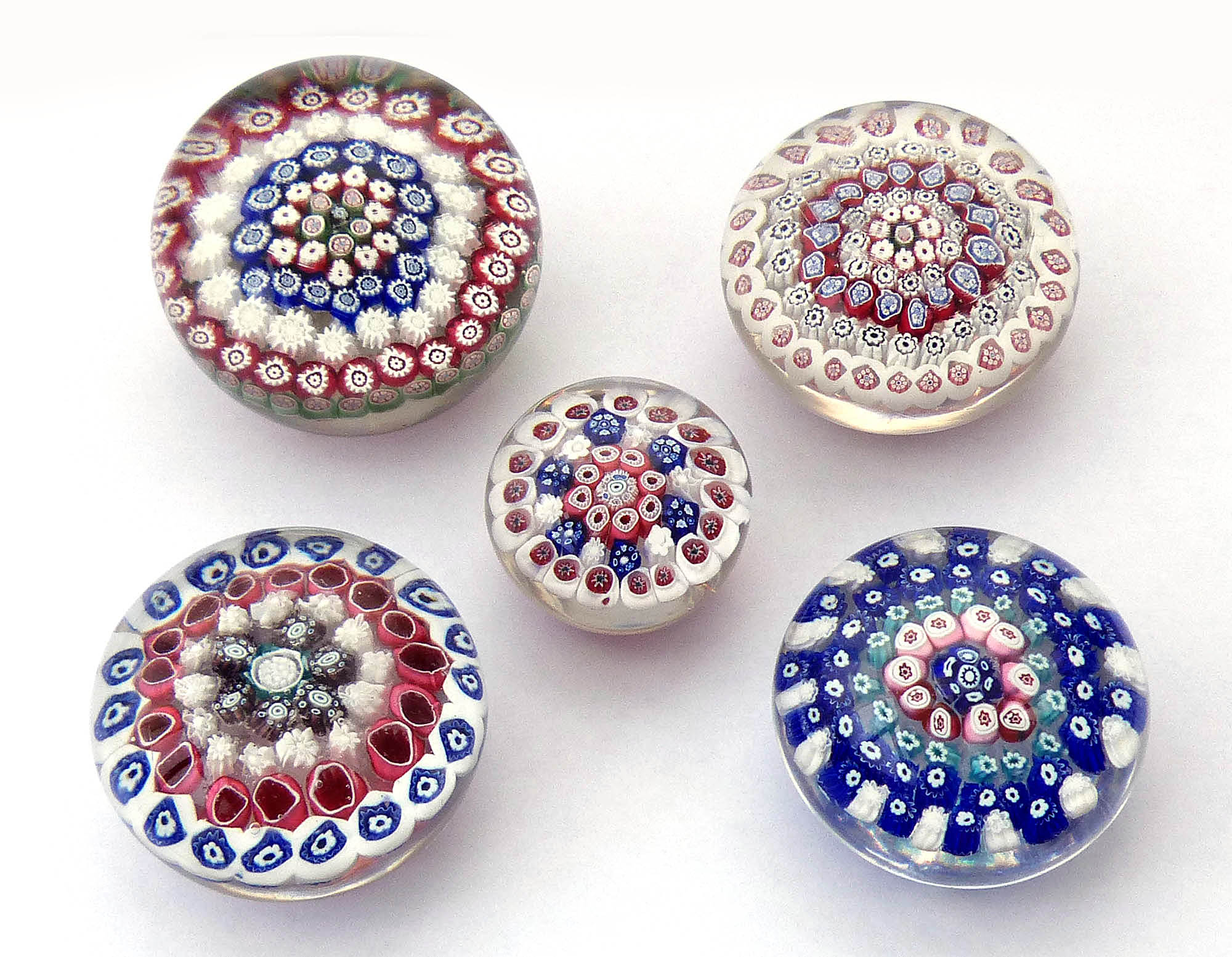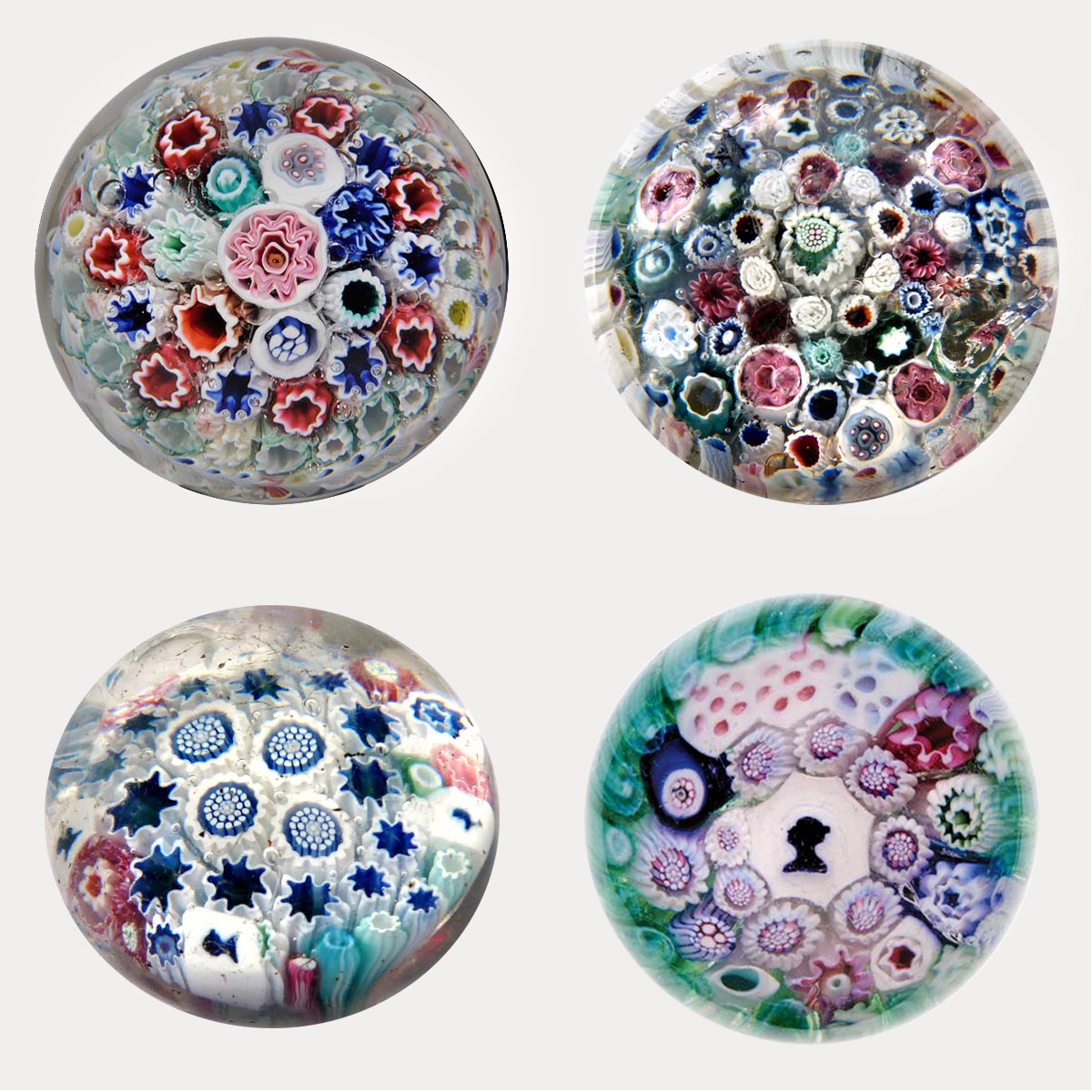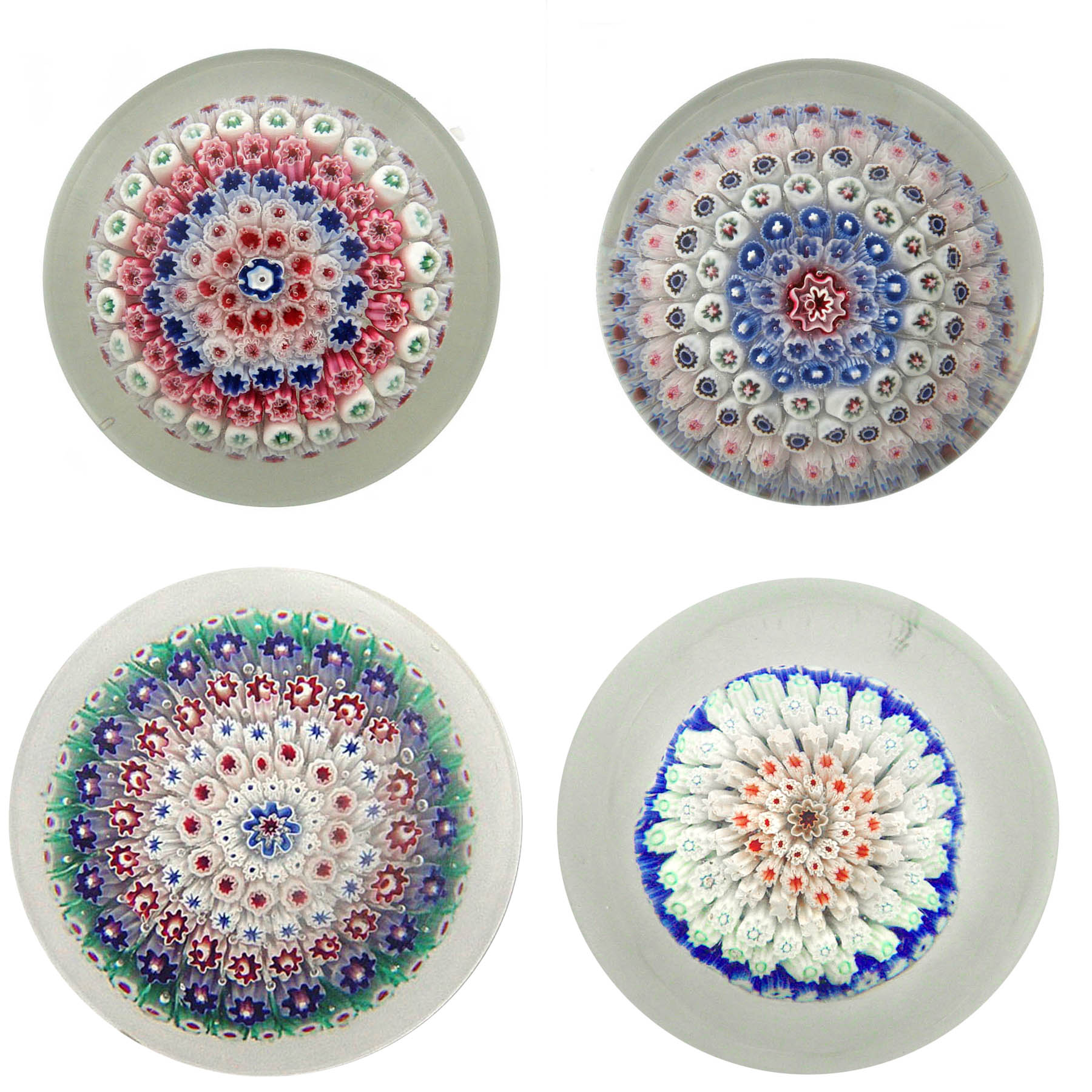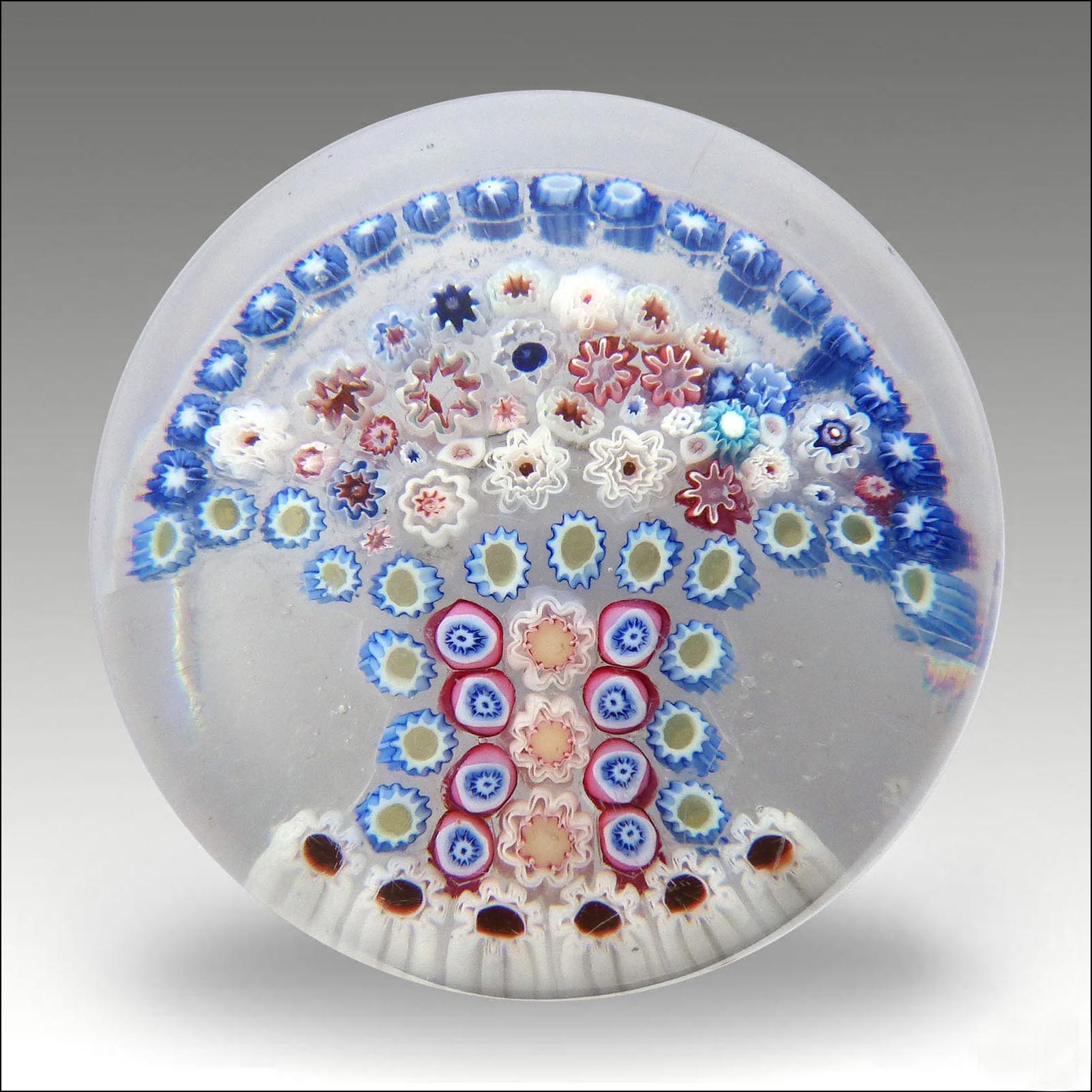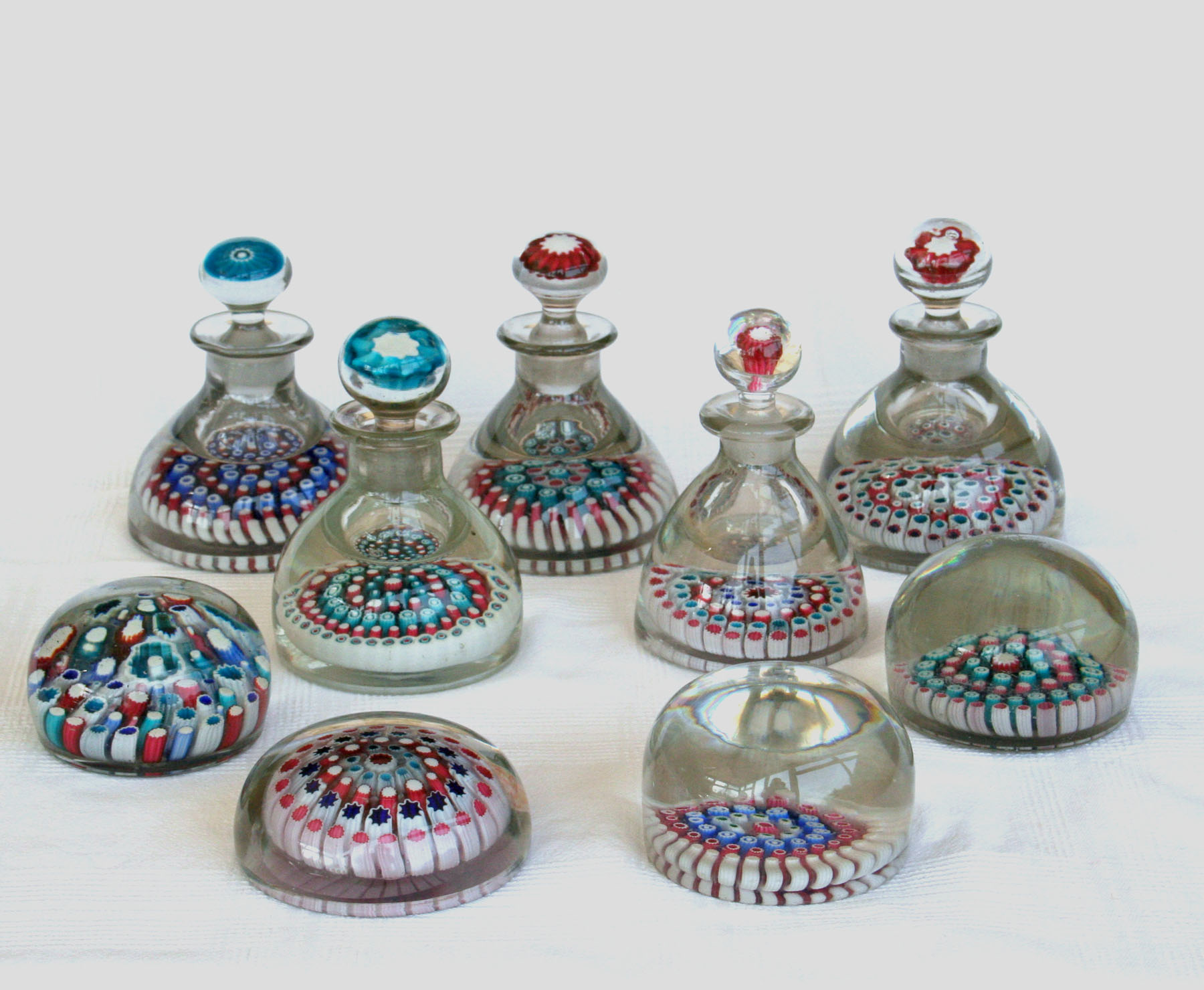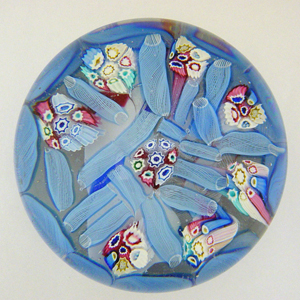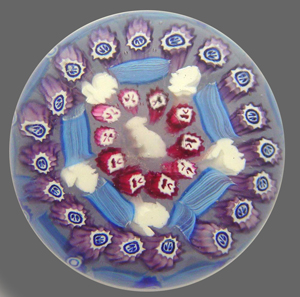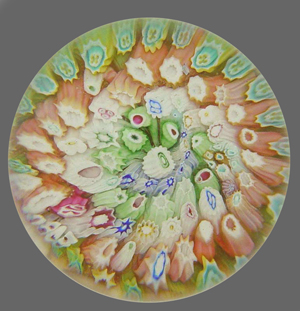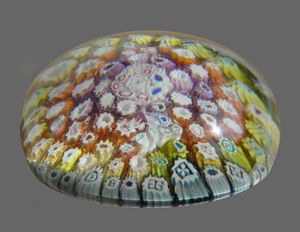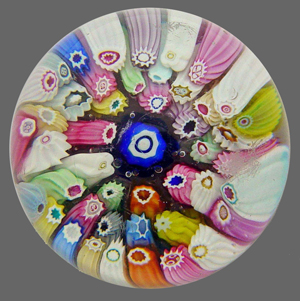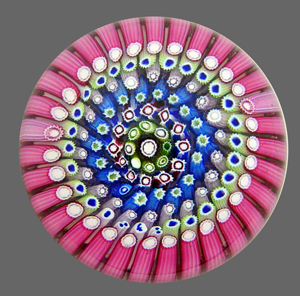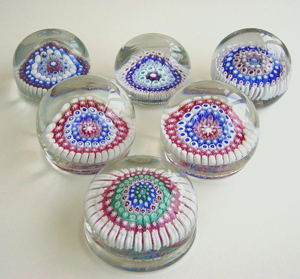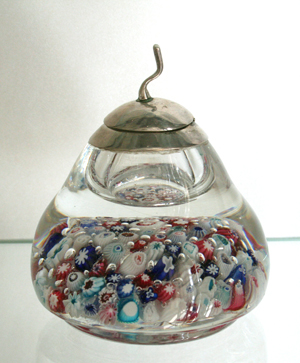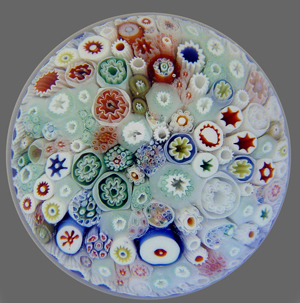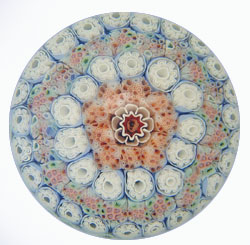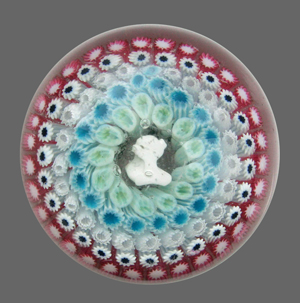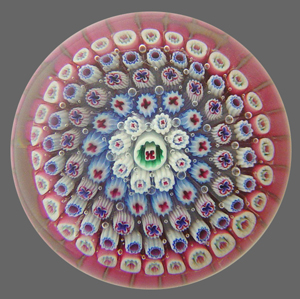 updated February 2024 |
|
|||||
|
NEW - Old English Gallery added 13 June 2015. So you have a paperweight, and think that it might be Old English. What can you do to be more confident about the attribution, and perhaps identify the manufacturer? Some points to consider. All Old English paperweights were made with lead crystal, which is a minimum of 24% lead. The majority have a higher lead content, with Walsh Walsh and Arculus running at about 33%. As a result the specific gravity should be between 2.900 and 3.250, and they should fluoresce blue under short wave UV light. If they don't meet these criteria, they are probably not OE weights (I realise that not many of us have equipment to make these tests). Many Old English weights are relatively large - over 3 inch / 75 mm diameter - but there are one or two smaller ones around. These are ofter re-ground bottle stoppers. Apart from two crude examples, as far as we know there are no Old English weights containing lampwork. As for makers, there were many competent crystal glass factories in the UK in the 19th century - over 40 are known - the majority in the Birmingham and Stourbridge area. Many of these might have made paperweights in the 1845 - 1860 period, because paperweights were profitable items. Some of these factories existed for very short times, and were then taken over by new owners, or sold along with their stock (including items such as molds, and canes). Workers moved around, and took techniques (and canes) with them. So trying to attribute paperweights by identifying the canes alone is a difficult and imprecise task, at best. It is my view that we have still not identified the factories that made some of the highest quality weights, such as the OE1 Group (see below). Antique Whitefriars - they do not exist. There is no evidence that Whitefriars made any paperweights before the 1930s, when some millefiori weights and bottles appear in a 1938 catalogue. And there is little evidence of more than an odd one being produced until the early 1950s. The use of the term follows a misunderstanding, propagated in part by Paul Hollister, following the purchase by a dealer in the USA, around 1950, of old Walsh Walsh stock (from 1930 - 1950) when the factory closed in 1950 . These paperweights, inkwells, shot glasses and so on found their way onto the market as 'Antique Whitefriars', perhaps because some contain '1848' canes - see below. Arculus - well documented and identifiable, as canes and items were retained in the family, and some are in Broadfield House glass museum. Produced items in the early 1900s, before being taken over successively by Hands and by Walsh Walsh (1930). Walsh Walsh certainly produced paperweights from the takeover of Arculus for several years, seemingly in both factories, and quite possibly until 1950 when they closed. They were an important high quality maker in the 1850s, and may have produced some paperweights then, but we have no evidence at present. If you find an Old English weight or ink bottle with the date '1848' in separate canes, often rather crudely done, it was virtually certainly made by Arculus or Walsh Walsh in the 1900 - 1930 period. Good pointers are also the '7/6' or 'window' canes. For more information see my article 'Alphabet Soup' in the PCA Bulletin 2006. The majority of weights from these two makers are concentric millefiori designs, usually with 5 to 7 rows. The profiles vary from flat to high sided, but there is rarely an 'undercut' like in classic French weights. Bases are rarely polished or ground - the pontil mark is very obvious. Quality varies from excellent to very poor. There are a few closepacks. Bottle stoppers do not always match the base design; indeed, this is so common that it is likely that some items left the factory that way. It is difficult to distinguish Arculus and Walsh Walsh products, but there are some pointers. The 'chequer' weights are thought to be made by Arculus, and also the 'low domed' concentric weights. The evidence suggests that Arculus made some of the more untidy weights, but could also make neat ones at times. Walsh Walsh collaborated with Whitefriars for certain glass products in the 1940s, and it could be that paperweight making expertise spread from the one to the other, explaining the similarity of some Whitefriars 1950s designs to some 1920s-1930s Arculus and Walsh Walsh pieces. This may be part of the source of confusion over 'Antique Whitefriars' pieces (the myth of the 1848 date canes being genuine, and by Whitefriars, was de-bunked several years ago, but persists in places). Richardson operated from 1810 to 1928 in various guises, but there are no records to say whether they made paperweights in the 1850s. It is unlikely that a top quality manufacturer would have missed out on the opportunity, as it was good business for a time. However, we do not know what such weights look like, if they exist! Records show millefiori perfume bottle designs in H G Richardson catalogues from around 1910, which are very similar to bottles and paperweights generally considered to be Richardson products. These are usually neat concentric designs, often with a white outer ring of canes. Many of these items have a distinct foot, but this is not unique to Richardson: I have seen a few Arculus / Walsh Walsh pieces with a foot. I have measured the specific gravity of certain glass items in the Richardson bequest in Broadfield House Glass Museum, and the results are consistent with those obtained from the 'Richardson' bottles and paperweights. So I think we can be confident about the attribution of certain designs to Richardson. I have not yet seen a Richardson item with a complex millefiori cane (one made by bundling existing canes together, re-heating, and re-pulling). For more information on Richardson paperweights see my article on 'Identifying Richardson Paperweights' in the PCC Newsletter Issue 60 april 2006 (reproduced later for the Jokelson prize in the PCA Newsletter 2007). For more information on Specific Gravity measurement and results see my article 'Old English Paperweights: Specific gravities, Two New groups, and Many More Questions' in the PCA Bulletin 2007. It does not require expensive equipment to measure Specific Gravity, but you do need to be careful and systematic and understand what you are doing! Make repeat measurements to establish your margin of error, and work at a set temperature (eg 20 deg C). I have put a chart of the SG measurements that I have made here. Bacchus and Rice Harris (Islington Glass Works) are both commended on the quality of their glass items, including paperweights, in various articles around 1848 -1851. So we can be confident they produced paperweights - but which? The rare weights with IGW canes are probably from the Islington Glass Works, but we have no proof. There are several hundred beautiful, large paperweights with complex canes and neat basket bases, attributed to Bacchus: again, we have no concrete evidence, and these are not attributed as Bacchus until around 1950. There are also some weights of poorer quality that have matching styles and canes, and that may represent earlier or later work from the same (unknown) factory. For more information on Islington paperweights see my 12 page article on 'Islington Paperweights' in the PCA Bulletin 2013). Queen's Head (QH) canes. It was once thought that a silhouette of Queen Victoria was strong evidence for attributing an Old English paperweight to Bacchus. Recent studies show that QH canes are more likely to be found in weights from other makers, including Richardson. For more information see my article 'Queen's Head Silhouette Canes' in the PCA Bulletin 2009, also PCC Newsletter Issue 99 April 2009. Gillinder. There are several distinct designs of the QH cane, and the one used by Gillinder in the US is not the one in Bacchus weights. There is no evidence that Gillinder worked at Bacchus, and the 'early history of Gillinder' in Hollister and elsewhere is incorrect. For more information see my article 'William Gillinder - The Early years' in the PCA Bulletin 2009. OE1 to OE6. I have identified several groups of weights (by style, cane matching, and density) that are from different manufacturers, but which we cannot at present identify. They probably date from the 'classic period' of 1845 - 1860, when paperweights were a profitable line. Any of several major glass makers and many minor ones in the Midlands might be responsible - possibilities include Joseph Webb, John Walsh Walsh, Stevens & Williams, Davis, Greathead & Green. I am hoping to find out more about the origins of these weights. OE1 weights are generally very neatly made, with concave polished bases. OE2 are much coarser, simpler designs, with a limited colour pallet, and frequently turn up as ink bottles. OE3 are relatively small, and some contain a 'B' cane. OE4 and OE5 have been confused with Bacchus pieces and labelled as suc. For more information on OE1 to OE6 see for example my various articles in the PCA Bulletin: 'Queen's Head silhouette canes' PCA Bulletin 2009 'William Gillinder - the Early Years' PCA Bulletin 2009 'Islington Paperweights' PCA Bulletin 2013 'Old English Paperweights Revisited- What do We Now Believe?' PCA Bulletin 2020 'See also Bob Hall's book 'Old English Paperweights' - link on the Books page.. This is the best book available on the topic, but it does contain a number of errors, and is now out of date in terms of the knowledge we have of the Old English makers. For a discussion of early and late Bacchus see my article 'Bacchus - Early, Late, or just On Time' in the PCC Newsletter Issue 88 August 2005. I hope this helps. I will always try to respond to questions - and images make questions much easier to answer. Alan Thornton Here are some more examples of Old English weights from unknown makers OE3 Group items OE4 Group items OE5 Group items OE6 example Below: more OE2 Group items
|
||||||
|
Arculus multicolour, and Walsh Walsh (or Arculus) with 1848 date |
||||||
|
Bacchus close-pack and concentric designs ************************************* |
||||||
|
OE 1 Group weights ************************************ |
||||||
|
OE2 Group items
************************************* |
||||||
